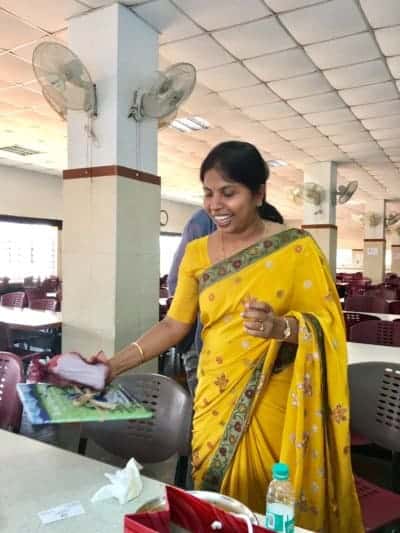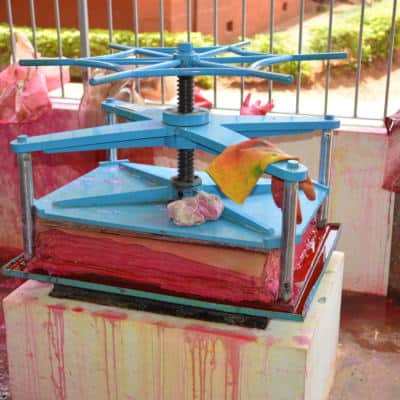Driving through the streets of Bangalore, it was next to impossible to avoid the street beggar selling a gadget to make a few rupees or see the garbage-filled slums inadvertently established next to a five-star hotel. This nation of what seemed only as the “haves” and “have-nots” stirred feelings in me about how unfair our world is and how lucky some folks are to be born into privilege while some are destined for a life of despair.
Each day in India, I reminded myself just how fortunate I was to be given the opportunity to dream and live out my dreams. I was the first in my family to graduate from college, let alone go to college. The children I saw wandering the slums of India made me wonder what hope they had of a future and if they even realized what their future could be like if they knew better.
As we drove past cows eating from piles of garbage in the median of the highway, I was further provoked when we pulled into a luxurious, gated private school. The steps leading up to the entrance of Vidyashilp Academy were made of Indian granite and marble. It seemed to me that only the children of royalty were privileged enough to step foot onto the school grounds. Did the children in the slums next door even know what it looked like on the other side of the gate?

With the mindset that I would have little to learn from Vidyashilp, I was stunned as our North Carolina delegation was greeted by the Head of School Selvi Kalai. One could easily tell by her demeanor, her gold-colored sari, and her eloquent diction that she was no-nonsense. As we were served tea, “normal” with milk, and biscuits, she provided us with an overview of the instructional program at her school.
Selvi started at Vidyashilp as a parent. She wanted her own children to benefit from the best education possible and wanted the same for others’ children. She quickly joined the staff as a teacher. Her passion for life-long learning led to her promotion to department head, then to vice principal, and most recently to the head of school (principal).

Talk is cheap, so, while intrigued by Selvi, I really wanted to see the school in action. I wanted to see if the inquiry-based learning and teacher-facilitator model was really true or not. I needed to see it to believe it.
We started our tour in the art wing of the school. Every corner held award-winning, wall-size paintings. Animal sculptures made of toothpicks and three-dimensional figures positioned in story-like settings all looked like works of art that belonged in museums. I was mesmerized to learn these were all created by the hands of the students at Vidyashilp. How could a STEM-focused country devote an entire wing of the school to art? This certainly piqued my interest.
We stumbled upon the journalism classroom, where students were creating age-specific newspapers. As early as Class 1 (first grade), students compiled pieces of writing to tell stories about the relevant happenings of their school lives.
As we ventured into the back of the school, we saw the paper-recycling machine. I could not believe that not only were the students creating new paper out of old notebooks, but also that they built the machine themselves. As I met the paper recycling teacher, I learned that he wanted to be an engineer and took a side job at Vidyashilp while he studied. Five years later, he changed his career path because he is happy at Vidyashilp.
He gave me a notebook made from the recycled paper that students produce and sell from their school supply store. The students created and sold everything from notebook paper to construction paper to computer paper to pencil boxes all made from the recycled paper.
Motivational quotes filled the walls of the school hallways. As I passed by a sign that read, “Every person is important…it doesn’t matter whether you play the violin, the flute, the cello, or the drums; you’re still a part of the orchestra,” I saw this mantra play out throughout our day. Students and teachers were genuinely happy to be at Vidyashilp, and the ways in which teachers engaged all types of students demonstrated that they valued every person for who they were and encouraged them to follow their dreams.
At the end of our tour, Selvi greeted us again. Each of us complimented her for the school culture and climate and commented on how engaging each classroom seemed to be. She mentioned to me that she has worked hard to establish a culture where everyone feels valued and heard and where everyone feels successful.
In spite of this seemingly perfect and happy school, Selvi mentioned that she still wanted to work harder in the area of teacher induction. While the structures she already has in place are a major step in the right direction, she still wants to be sure she keeps the best teachers at her school.

Teachers choose to leave the classroom for a variety of reasons. A recent report by the Learning Policy Institute pointed out two very important factors that contribute to teacher retention: principal leadership style and administrative support. Even 4,000 miles away in Bangalore, at a school like Selvi’s, this seems to be the case.
Selvi and I have stayed in touch since we met in India. We scheduled a Google hangout, where I shared with her some key strategies related to instructional coaching and professional development. Providing specific, high-leverage feedback on effective teaching resounded with Selvi. She felt this would help her meet the needs of all teachers because feedback is based on the context of their own classrooms. She was also very interested in professional development that was specific to teacher needs based on what she sees in her student data.
Selvi’s comments confirmed the work of the NC New Teacher Support Program, a system-wide effort to support beginning teachers through schools of education in more than half of the state’s school districts. She was intrigued by the university-based induction work we are doing in North Carolina, especially the intentional and ongoing feedback instructional coaches provide beginning teachers in the areas of planning, instruction, and assessment. Her genuine desire to keep the best teachers for the children in her school impressed me. I know we will continue to stay in touch.
While I am so thrilled to have made a connection between India and North Carolina, my heart is still heavy for the children who do not have the opportunity to attend a school like Selvi’s. Much work remains to be done.
Recommended reading






